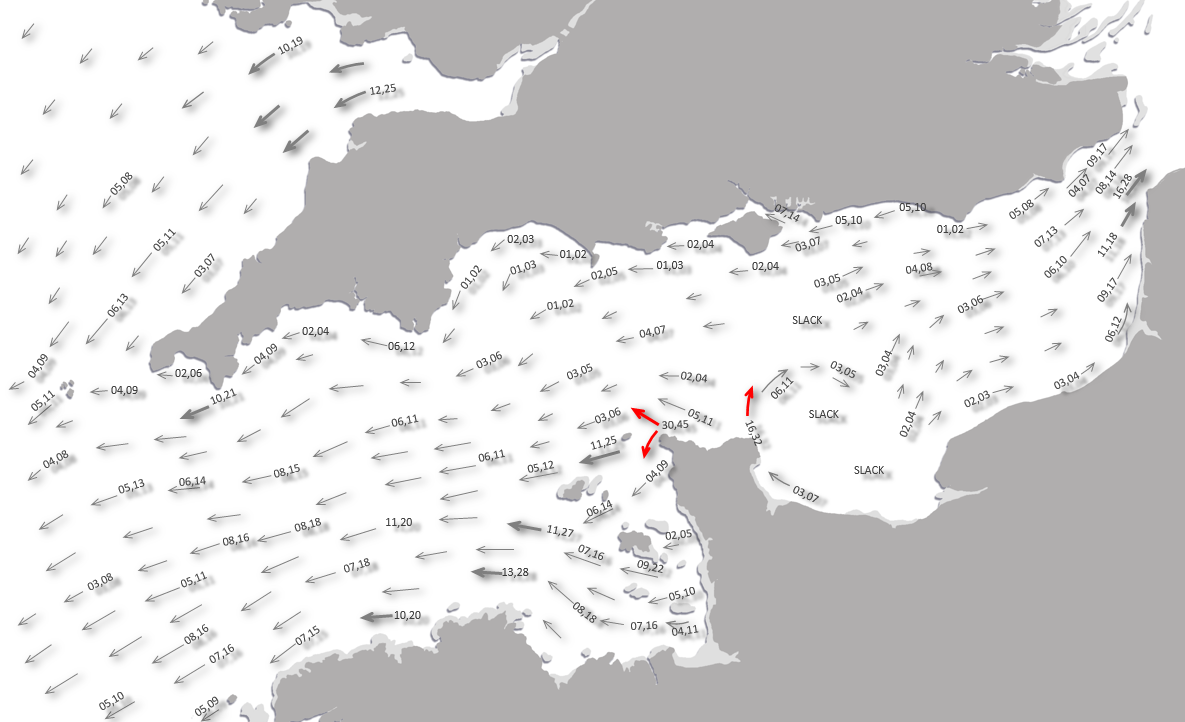- +Local Tides and Tidal Streams
- +Predict Future Tidal Windows
- +Route Weather
- +Find Routes
- +Find Havens
- +Navigational Resources
- • Tropical Maritime Air Mass - from the Atlantic
- • Polar Maritime Air Mass - from Greenland
- • Arctic Maritime Air Mass
- • Polar Continental Air Mass - from central Europe
- • Tropical Continental Air Mass - from North Africa

Small tidal stream inaccuracies can develop when advancing beyond HW Dover +6. Because of this we only enable today's tidal stream chartlets to advance 24 hours. Sorry, future tides are not currently available for this harbour. Please check Admiralty EasyTide.
The above image represents the current tidal streams offshore of this haven. Streams attaining three knots and above are highlighted by red arrows
 . All times are in local time with red text indicating springs, blue indicating neaps and gray between tidal events. Click [+] to advance the estimate by an hour and click [-] to step back.
. All times are in local time with red text indicating springs, blue indicating neaps and gray between tidal events. Click [+] to advance the estimate by an hour and click [-] to step back.
Do you need more information on the tidal graphics?
Arrows represent the direction of tidal streams with lighter or shorter arrows indicating weaker streams. Stronger streams are indicated by heavier or longer arrows, and as mentioned above, red arrows flagging rates of 3 knots and above. Numerals represent [mean neap, mean spring] rates in tenths of a knot. For example the numbers 12,23 would indicate a mean neap of 1.2 knots and a mean spring of 2.3 knots.
More local tidal details
Today's tides — High water: , Low water:Today's Dover tides — High waters: 05:23, 17:59, Low water: 12:30
We are now on Neaps. View future tidal events in our lunar calendar


Spring and neap tides are caused by the gravitational attraction of the moon and to a lesser extent the sun. The complex mix of gravitational forces raise bulges of water on both sides of the Earth. These vary in size depending upon the moon's position as it revolves around the Earth each month.
When the moon's orbit places both the moon and the sun's gravitational forces in line, during New Moon  and Full Moon
and Full Moon  , the water level rises higher, falls lower and the tidal runs are faster than usual. These are called spring tides, shown in red. When the moon is in the First Quarter
, the water level rises higher, falls lower and the tidal runs are faster than usual. These are called spring tides, shown in red. When the moon is in the First Quarter  or Last Quarter
or Last Quarter  , out of phase with the sun, lower tides result and lesser tidal runs will be experienced. These are called neap tides, shown in blue.
, out of phase with the sun, lower tides result and lesser tidal runs will be experienced. These are called neap tides, shown in blue.
The maximum spring tide typically lags a day behind the date of New and Full Moon in the British Isles. This is caused by the water masses inertia and friction plus the physics of 'cause and effect' where the largest impact occurs after the force has been imparted.

This tool can be used to estimate future costal tidal streams for this area. All that is required are two simple steps:
Step 1: What is the Dover High Water for the target date?
Use a current Dover Tide Table to find Dover High Water for the target date. The National Oceanography Centre offers online tidal predictions for up to 28 days from today. Click here to open their tide table for Dover

Step 2: Input the target date's Dover High Water
Taking a mean tidal offset from Dover's tide, we expect your targetted date's associated local tide at to be:
High waters: Low waters:
Data based on an average tide is only accurate to within one hour, if you more precise times are required use the ISA tidal predictions, with offset -01:00.
| Today's overview |
||||
 |
 |
 |
 |
 |
| °C °C |
°C °C |
°C °C |
°C °C |
°C °C |
Headline: Sunny spells and isolated showers.
Today: A drier day with plenty of sunny spells, though the odd shower still possible. Another breezy day though winds much lighter than on Monday. Feeling fresher than of late. Maximum Temperature 12C.
Tonight: Remaining dry for most overnight with some clear spells, although a few showers still possible. Winds easing and tuning chilly, with some patchy frost in prone rural spots. Minimum Temperature 5C.
Wednesday: A chilly but mostly dry and bright stay to the day. Turning cloudier later with showers and patchy rain at times. Breezy, and temperatures around average. Maximum Temperature 12C.
Outlook for Thursday to Saturday: Dry and chilly to start on Thursday, but outbreaks of rain spreading southeast overnight. Turning drier through Friday with sunny spells into the weekend, and temperatures around average.

Click [+] to advance by twelve hours and click [-] to step back. The forecasted time is presented in the top left hand corner of the pressure chart. Click the image to display it in a full window.
 Get today's Met Office Video Forecast
Get today's Met Office Video Forecast
Welcome to the 'find routes' tool. Use this tool to discover all the coastal descriptions, short cuts, and tidal strategies we offer for a particular passage between our listed destinations; more information.
All pages provide our menu bar, to navigate to and browse through listed 'Routes', plus our site wide text search capability. The text search capability may be narrowed to individually target 'Experience', 'Routes' or 'Havens' by selecting the tabs beneath the search box. But text searches are not optimal when it comes to finding Routes pertaining to a particular passage unless you know what you are looking for. This is what our 'Find routes' tool is for.
'Find routes' exposes all published 'Routes' information that may be of interest for a specific passage. This is easily achieved by selecting where you are, or a nearest Haven, and the desired destination, or its nearest Haven. Then click 'Go' and 'Find routes' does the rest.
 |  |  |
 |  |  |
| Set your current location | Set the maximum distance you are prepared to travel | Check off what you want |
May to September is the traditional UK Sailing season with June-July offering the best weather. The British Isles weather is highly variable, and the amount of bad weather varies quite widely from year to year. This is because they are islands positioned between the Atlantic Ocean and the large landmass of continental Europe. As a result, the entire area lays under an area where five main air masses meet and alternate:
Depending on the movements of the jet stream, any and all of these air masses can come in over the isles, creating weather fronts where they meet and bringing with them all types of weather.
The prevailing winds for the British Isles as a whole are from the western quarter which generally blows for two-thirds of the year predominantly from the southwest. Gales from the westward are felt in all seasons, but from November to March, inclusive, they are most frequent and generally last three or four days. Of these, a southwest gale is considered to be the most powerful system. The winter period is largely characterised by wind and rain.
The fine summer weather of the sailing season is typically punctuated by the passage of an Atlantic depression that bringing periods of strong wind and rain, and sometimes poor visibility. These gales rarely cause surprises as they are usually forecasted well in advance. Good weather windows of 48 hours are easy to predict but any longer than that there's an increasing chance of change.
Fogs are frequent in all parts of the Channel and are formed both on the English and French coasts. In summer they only obscure the land in the morning and are readily dispersed by heat or a light breeze. But the moist haze, driven in by westerly winds from the sea, tends to linger and is only dispersed by strong winds. In the eastern part of the Channel, it is rare for the land to be completely free from mists. The only exception is when the wind is from the northeast which makes the mist free coastline highly distinctive from a great distance.
Please note eOceanic makes no guarantee of the validity of this information, we have not visited this haven and do not have first-hand experience to qualify the data. Although the contributors are vetted by peer review as practised authorities, they are in no way, whatsoever, responsible for the accuracy of their contributions. It is essential that you thoroughly check the accuracy and suitability for your vessel of any waypoints offered in any context plus the precision of your GPS. Any data provided on this page is entirely used at your own risk and you must read our legal page if you view data on this site. Free to use sea charts courtesy of Navionics.


